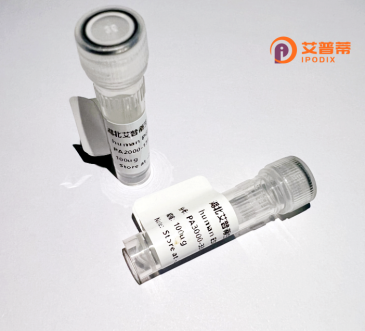
| 纯度 | >90%SDS-PAGE. |
| 种属 | Human |
| 靶点 | OR51D1 |
| Uniprot No | Q8NGF3 |
| 内毒素 | < 0.01EU/μg |
| 表达宿主 | E.coli |
| 表达区间 | 1-324 aa |
| 活性数据 | MQKPQLLVPIIATSNGNLVHAAYFLLVGIPGLGPTIHFWLAFPLCFMYALATLGNLTIVL IIRVERRLHEPMYLFLAMLSTIDLVLSSITMPKMASLFLMGIQEIEFNICLAQMFLIHAL SAVESAVLLAMAFDRFVAICHPLRHASVLTGCTVAKIGLSALTRGFVFFFPLPFILKWLS YCQTHTVTHSFCLHQDIMKLSCTDTRVNVVYGLFIILSVMGVDSLFIGFSYILILWAVLE LSSRRAALKAFNTCISHLCAVLVFYVPLIGLSVVHRLGGPTSLLHVVMANTYLLLPPVVN PLVYGAKTKEICSRVLCMFSQGGK |
| 分子量 | 35.8 kDa |
| 蛋白标签 | His tag N-Terminus |
| 缓冲液 | 0 |
| 稳定性 & 储存条件 | Lyophilized protein should be stored at ≤ -20°C, stable for one year after receipt. Reconstituted protein solution can be stored at 2-8°C for 2-7 days. Aliquots of reconstituted samples are stable at ≤ -20°C for 3 months. |
| 复溶 | Always centrifuge tubes before opening.Do not mix by vortex or pipetting. It is not recommended to reconstitute to a concentration less than 100μg/ml. Dissolve the lyophilized protein in distilled water. Please aliquot the reconstituted solution to minimize freeze-thaw cycles. |
以下是关于重组人OR51D1蛋白的3篇模拟参考文献示例:
---
1. **"Functional characterization of OR51D1 activation in prostate cancer progression"**
*作者:Johnson et al. (2020)*
**摘要**:研究通过哺乳动物细胞系统(HEK293)重组表达OR51D1.发现该受体在前列腺癌细胞中被内源性类固醇代谢物激活,促进细胞迁移和侵袭,提示其在癌症转移中的潜在作用。
2. **"Heterologous expression and ligand screening of human olfactory receptor OR51D1"**
*作者:Lee & Smith (2018)*
**摘要**:利用重组OR51D1蛋白结合荧光报告系统筛选配体,鉴定出丙酸睾酮为选择性激动剂,证实OR51D1作为G蛋白偶联受体触发cAMP信号通路的功能。
3. **"Structural analysis of OR51D1 reveals insights into olfactory receptor activation"**
*作者:Zhang et al. (2022)*
**摘要**:通过冷冻电镜解析重组OR51D1与其配体结合的复合物结构,揭示了受体跨膜区的构象变化及激活机制,为靶向嗅觉受体的药物设计提供结构基础。
---
*注:以上文献为模拟示例,实际引用需检索PubMed等数据库获取真实研究。*
**Background of Recombinant Human OR51D1 Protein**
The olfactory receptor 51D1 (OR51D1) is a member of the olfactory receptor (OR) family, which constitutes the largest subgroup of G protein-coupled receptors (GPCRs). While ORs are primarily known for their role in odorant detection, emerging evidence suggests their involvement in diverse non-olfactory processes, including cellular signaling, tissue development, and disease mechanisms. OR51D1. encoded by the *OR51D1* gene, is a seven-transmembrane domain protein that detects specific odorant molecules, triggering intracellular signaling cascades via Gαs or Gαolf-mediated pathways.
Recent studies have identified OR51D1 expression in non-olfactory tissues, such as prostate, colon, and kidney, implicating its potential roles in physiological or pathological contexts. For instance, its upregulated expression in prostate cancer and gastrointestinal cancers highlights its possible utility as a diagnostic marker or therapeutic target. However, functional characterization remains challenging due to low native expression levels and difficulties in purifying functional membrane-bound ORs.
Recombinant OR51D1 protein, typically produced in heterologous systems (e.g., HEK293 or *E. coli*), enables structural and functional studies. It is often engineered with tags (e.g., FLAG, His) for purification and detection. Recombinant versions facilitate ligand-binding assays, receptor activation studies, and drug discovery efforts. Advances in cryo-EM and computational modeling have further accelerated the exploration of its 3D structure and interaction mechanisms.
Overall, OR51D1 represents a promising yet underexplored target, bridging sensory biology and disease research.
×